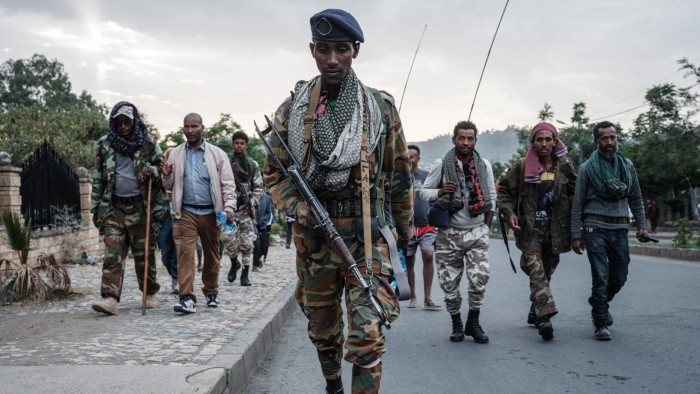Unlock the Editor’s Digest for free
An outbreak of factional fighting in northern Ethiopia has led Africa’s second most populous country back to the brink of civil war and threatens to reignite a conflict with neighboring Eritrea, regional officials have warned.
A dissident faction of the Tigray People’s Liberation Front (TPLF), the ruling party in the state of Tigray, has seized parts of the regional capital Mekelle and taken control of the area’s second-largest city Adigrat, in what regional officials and experts said amounted to a “coup.”
Ahmed Soliman, a Horn of Africa expert at UK think-tank Chatham House, said the situation posed grave security concerns for both Ethiopia and Eritrea.
“We’ve got a very fragile peace agreement which is unraveling at the moment,” he said, adding that Tigray’s chief administrator Getachew Reda had essentially been hounded out of office by a rival TPLF faction led by its chair Debretsion Gebremichael.
“This may lead to a war between Addis [Ababa] and Tigray and the suggestion is that Debretsion’s TPLF has struck up an alliance with their biggest enemy, the Eritrean government. An alliance on the basis of my enemy’s enemy is my friend.”
Ethiopia’s two-year civil war between 2020 and 2022 claimed as many as 600,000 lives, making it one of the world’s deadliest conflicts of recent times. Eritrean troops fought on the side of the Ethiopian federal army and were accused of mass killings and rape.
Relations between the two countries have steadily worsened since the civil war came to an end in November 2022, after a peace agreement that Eritrea was not party to. There are consistent reports of a build-up of troops on both sides of the border.
Ethiopia’s former chief of army staff General Tsadkan Bayru, who fought on the Tigrayan side in the civil war, warned in a column published last week by the Africa Report magazine that “at any moment war between Ethiopia and Eritrea could break out . . . and the security of the Red Sea will be directly affected.”
Getachew, who has been in Ethiopia’s capital Addis Ababa since last week, wrote on X on Tuesday that the fighting in Tigray was part of a “hare-brained plan to install an illegal faction of TPLF into the position of power,” which risked escalating into “another round of devastating war.”
In a veiled reference to Eritrea, he added that “there is every reason to believe external forces are trying to take advantage of this crisis.”
Eritrea’s government spokesperson Yemane Gebremeskel has denied claims that soldiers from his country had remained active inside the Ethiopian border in Tigray and said another war between Eritrea and Ethiopia would be “senseless.”
But he added that the accusations could be a pretext for Ethiopia to unleash a hostile agenda and attempt to take back control of the Massawa and Assab ports, which it lost when Eritrea gained independence after a 30-year liberation war in 1992.
“The constant sabre-rattling is too intense to shrug it off as simple posturing,” said Gebremeskel.
Soliman of Chatham House said if Ethiopian federal forces intervened in Tigray on behalf of Getachew it could suck in Eritrea, triggering a regional war.
“There’s talk of a build-up of forces, with some evidence of a mobilization on the Afari-Eritrean border. The worry of that would be a regional confrontation. It’s the last thing the people of Tigray or the region need.”
Cartography by Ian Bott
This detailed article highlights the escalating tensions in northern Ethiopia and the potential consequences for the region. The delicate balance between Ethiopia and Eritrea is at risk, with factional fighting threatening to plunge the countries back into conflict. The intricate web of alliances and rivalries adds complexity to the situation, raising concerns of a wider regional war. The need for diplomacy and de-escalation is paramount to prevent further bloodshed and instability in the Horn of Africa. The field of artificial intelligence (AI) has made significant advancements in recent years, revolutionizing various industries and improving the way we live and work. From self-driving cars to virtual assistants, AI has become an integral part of our daily lives. One of the most exciting developments in AI is the concept of generative adversarial networks (GANs), which have the potential to create incredibly realistic and convincing content.
GANs are a type of neural network architecture that consists of two networks – a generator and a discriminator – that work together to create new data that is indistinguishable from real data. The generator creates new data samples, while the discriminator evaluates the authenticity of these samples. Through this iterative process, the generator learns to produce increasingly realistic data, while the discriminator learns to distinguish between real and fake data.
One of the most impressive applications of GANs is in the field of image generation. GANs have been used to create photorealistic images of people, animals, and even landscapes. These images are so realistic that it can be difficult to distinguish them from real photographs. This has implications for a wide range of industries, from entertainment and media to fashion and design.
Another exciting application of GANs is in the field of text generation. GANs can be trained to generate coherent and contextually relevant text, such as news articles, stories, or even poetry. This has the potential to revolutionize the way we produce content, allowing for the creation of high-quality, engaging text at a fraction of the time and cost.
GANs have also been used in the field of video generation, where they can create realistic videos of people or objects in motion. This has implications for industries such as film and television, where GANs can be used to create special effects or even generate entire scenes. GANs can also be used to enhance video quality, by generating high-resolution images from low-resolution inputs.
While GANs have incredible potential, they also raise ethical concerns, particularly around the creation of fake content or deepfakes. Deepfakes are AI-generated videos or images that appear to show real people saying or doing things that they never actually did. This has implications for misinformation, privacy, and even national security.
Despite these concerns, GANs have the potential to revolutionize the way we create and consume content. From realistic images and videos to engaging text and stories, GANs are pushing the boundaries of what AI can achieve. As researchers continue to refine and improve GANs, we can expect to see even more impressive applications in the future.








